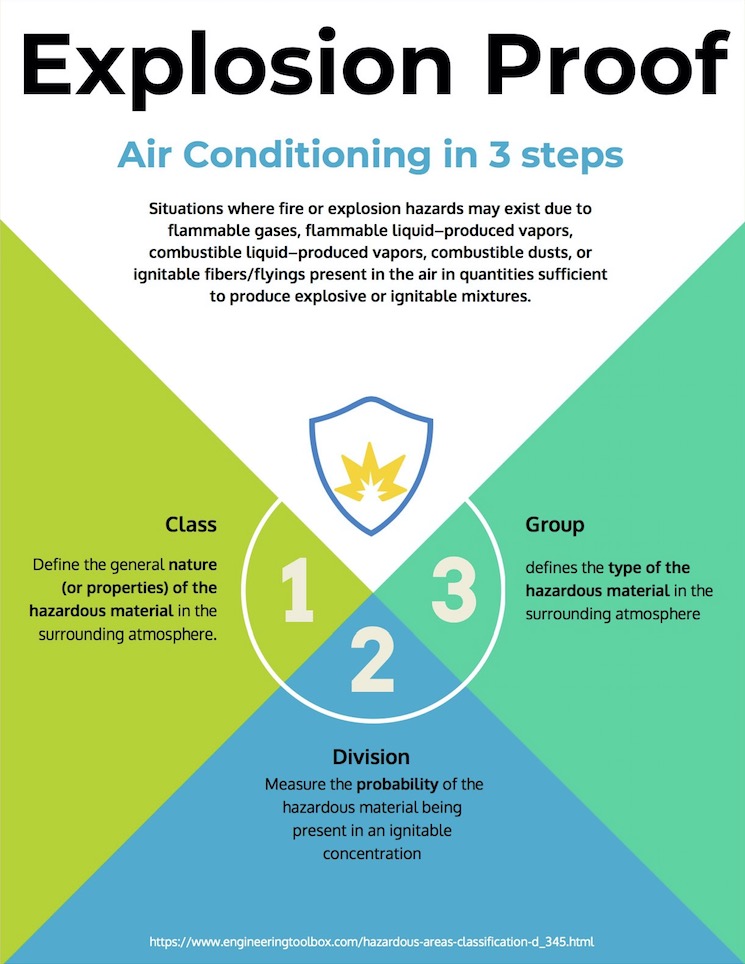Is a Non-Explosion Proof Air Conditioner a Ticking Time Bomb?
As much as the evening news would have a hay-day with that headline, most of us can relax, the air conditioner in your house is no more likely to explode than the TV hanging on your wall. However, in some industrial situations, the phrase Explosion Proof air conditioner has come to mean an HVAC unit in a hazardous or classified environment that will not become an ignition source through spark or arch through normal use of the unit. An explosion proof air conditioner is one that was built or modified so it does not become an ignition source in a hazardous location where gases, dust or fibers are, or may be present in combustible concentrations.
There are many environments where explosion risks exist. The most obvious being environments where flammable fumes and gases are present. Paint and chemical plants, mines and the oil and gas industries. Less obvious are flammable dust, metals, and grains. Dust explosions can happen when combustible material is dispensed in high enough concentrations with oxidizing gases like oxygen. A google search of “Dust Explosion” will yield many tragic accidents where everyday products like sugar, wheat, and metal were the propellant in accidents.
What are the Explosion Proof standards?
The needs of a grain processing plant are going to be different from an oil refinery. That’s why in North America the hazardous locations are classified in: classes, divisions & groups. It’s a simple system with 3 Steps to help you define a hazardous location the HVAC unit must operate in.

Step 1: Class
Helps you define the general nature or properties of the hazardous material. It can be one of three options.
• Flammable gasses or vapors are present (or may be present) in quantities sufficient to produce explosive or ignitable mixtures.
• Combustible or conductive dust are present (or may be present) in enough amounts to produce explosive or ignitable mixtures.
• Ignitible fibers or flyings are present (or may be present) in quantities sufficient to produce explosive or ignitable mixtures.

Step 2: Division
Division measures the probability of the hazardous material being present in an ignitable concentration as defined:
 High probability – The explosive mixture is present continuously, intermittently or periodically as part of routine operating conditions.
High probability – The explosive mixture is present continuously, intermittently or periodically as part of routine operating conditions.
 Low probability – The substance has a low likelihood of producing an explosive or ignitable mixture during abnormal conditions – such as a container failure or system breakdown.
Low probability – The substance has a low likelihood of producing an explosive or ignitable mixture during abnormal conditions – such as a container failure or system breakdown.
Step 3: Groups
Groups define the type of hazardous material you’re dealing with in the atmosphere. It groups hazard by the letter. Letters A, B, C & D are gas related while letters E, F & G are dusts.
 Defining the hazards is paramount when designing a system that works in your environment. Each Class, Division, and Group brings with it unique challenges we must consider when manufacturing or modifying your unit.
Defining the hazards is paramount when designing a system that works in your environment. Each Class, Division, and Group brings with it unique challenges we must consider when manufacturing or modifying your unit.
Does The Entire Air Conditioner Need to Be Explosion Proof?
Not necessarily. Manufacturing an explosion proof air conditioner is a time consuming and expensive process, so It’s best to locate as much electrical equipment as possible outside a classified area. Fortunately, air conditioners come in two different parts: an “Indoor Section” (Evaporator) and “Outdoor Section” (condenser) so you can modify the section that comes into contact with the classified location. A manufacturing facility may have dusts, fibers or gasses inside a building but the outside is unclassified. In this scenario, it’s possible only the “Indoor Section” (Evaporator) will require explosion proofing. The inverse is also true for a refinery example. A Blast resistant module may be non-hazardous on the inside but need to operate in an environment on the outside that may have flammable gasses. Isolating the part of your system to the hazardous space can save time and money. Build your unit with our online tool and we’ll help you figure out what is best for your situation.
How do you Explosion Proof an air conditioner?
The underlying concept is simple. Eliminate or isolate any components with a potential to arch or spark. Practically speaking, that means going through a system with hundreds of parts that’s mechanically, and electrically connected and removing all the risk. Some solutions are as simple as swapping out a steel fan blade with an aluminum one to eliminate the possibility of it sparking if it comes in contact with something else. Attention to how units are wired and how each connection is made to every component. Explosion proof enclosures for components that do pose a risk and perhaps even rewiring the entire unit with an intrinsic wiring. Each unit is unique to the hazards and requirements of the location.

